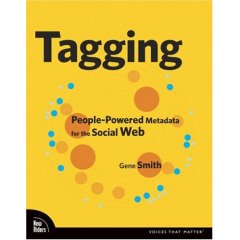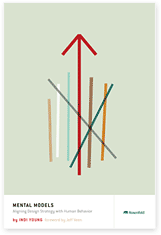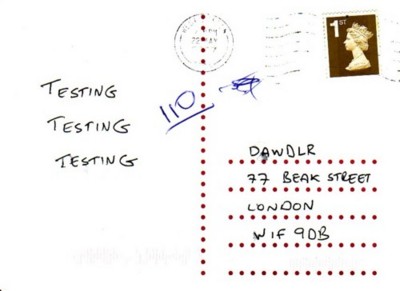Discount Code For Rosenfeld Media
Use the discount code FOJOEL10 to receive 10% off Rosenfeld Media books purchased online. Everyone loves a bargain!
experience design, emerging media, business and technology [circa 2014…]
Use the discount code FOJOEL10 to receive 10% off Rosenfeld Media books purchased online. Everyone loves a bargain!
If you’re interested in tagging and social metadata, social bookmarking, or information management, be sure to check out Gene Smith’s Tagging: People-Powered Metadata for the Social Web recently published by from New Riders. I reviewed some of the early drafts of the book, and it’s come together very nicely.

Tagging takes a very practical approach, and provides an ample set of examples in support of the insightful analysis. After an overview of tagging and its value, the book addresses tagging system design, tags in relation to traditional metadata and classification systems, and covers the user experience of creating and navigating tag clouds.
Gene likes to build things, so Tagging includes a chapter on technical design complete with suggested tools and tutorials for creating your own tagging apps.
All in all, Tagging is a worthy introduction to the subject, and a guide for deeper exploration.
While we’re talking books, kudos to Rosenfeld Media on the publication of their first book, Mental Models; Aligning Design Strategy with Human Behavior, by the very talented Indi Young!

Mental Models is richly illustrated, filled with examples, lucid, and accompanied by a considerable amount of additional content from the Rosenfeld Media website.
Indi has considerable experience teaching others the techniques and methods behind creating insightful mental models for audiences and customers. Cognitive / frameworky methods can feel a bit heady at times (especially how-to’s on those methods), but Mental Models is straightforward reading throughout, and an eminently practical guide to using this important tool for user experience design and strategy.
Mental Models is available electronically as a .pdf for individual and group licenses, or in hard copy; it’s choose your own medium in action.
Comment » | Reading Room, Tag Clouds, User Experience (UX), User Research
Video of my BlogTalk presentation ‘What happens when everyone designs social media? Practical suggestions for handling new ethical dilemmas’ is available from Ustream.tv. The resolution is low (it was shot with a webcam) but the audio is good: follow along with the slides on your own for the full experience.
More videos of BlogTalk sessions here.
Comment » | Ethics & Design, Networks and Systems, Social Media, User Experience (UX)
The design of JetBlue’s new terminal at JFK as reported in the NY Times is a good example of the intersection of user experience design, and the specific technical and political requirements of the post-9/11 security-oriented state. The layout of the new terminal is focused on directing passengers as quickly as possible through a screen of 20 security lanes, and includes thoughtful features like wide security gates to accommodate luggage and wheelchairs, and rubber flooring for areas where people end up barefoot.
I’m of two minds about designing experiences and architectures specifically to enable security purposes. Anything that improves the currently miserable experience of passing through security screenings is good. (I am waiting for reports on people who show up at the gate wearing only a speedo one of these days, just to make a point.)

But in the long run, do we really want experience design to help us become culturally accustomed to a security-dominated mindset? Especially to the point where we encode this view of the world into our infrastructure? Lurking not so quietly below the surface of the design of the new JetBlue terminal is Bentham’s Panopticon (full contents here). The new terminal’s floor plan is a classic funnel shape, disturbingly similar in concept to the abattoir / apartment block described in the famous Monty Python Architect Sketch.
Pace layering makes clear that architectures change slowly once in place. And authorities rarely cede surveillance capabilities, even after their utility and relevance expire. Should experience design make an architecture dedicated to surveillance tolerable, or even comfortable?
Comment » | Architecture, Ethics & Design, User Experience (UX)
Boxes and Arrows just published Enhancing Dashboard Value and User Experience, part 5 of the building blocks series that’s been running since last year. This installment covers how to include high-value social and conversational capabilities into portal experiences built on top of architectures managed with the building blocks. Enhancing Dashboard Value and User Experience also provides an explicit user experience vision for portals, metadata and user interface recommendations, and as tips on making portals easier to use and manage / administrate.

Thanks again to all the good people who volunteer their time to make Boxes and Arrows such a high quality publication!
Comment » | Building Blocks, Dashboards & Portals, Enterprise, Information Architecture, User Experience (UX)
Thanks to Facebook’s public mistakes and apology to those affected by Beacon , as well as a number of other ham-handed attempts to monetize the social graph, the intersection of ethics, design, and social networks is receiving overdue attention. Two talks at this year’s Information Architecture Summit in Miami will look at ethics as it applies to the daily work of creating social networks, and user experiences in general.
First is Designing for the social: Avoiding anti-social networks, by Miles Rochford, description below.
This presentation considers the role of traditional social networks and the role of IAs in addressing the challenges that arise when designing and using online social networks.
The presentation discusses philosophical approaches to sharing the self, how this relates to offline social networks and human interactions in different contexts, and provides guidance on how online social networking tools can be designed to support these relationships.
It also covers ethical issues, including privacy, and how these can conflict with business needs. A range of examples illustrate the impact of these drivers and how design decisions can lead to the creation of anti-social networks.
Related: the social networks anti-patterns list from the microformats.org wiki.
The second is The impact of social ethics on IA and interactive design – experiences from the Norwegian woods, by Karl Yohan Saeth and Ingrid Tofte, described as follows:
This presentation discusses ethics in IA from a practical point of view. Through different case studies we illustrate the impact of social ethics on IA and interactive design, and sum up our experiences on dealing with ethics in real projects.
If you’re interested in ethics and the practicalities of user experience (and who isn’t?), both sessions look good. I’ll be talking about other things at the summit this year. In the meantime, stay tuned for the second article in my UXMatters series on designing ethical experiences, due for publication very soon.
Comment » | Ethics & Design, Ideas, Information Architecture, Networks and Systems, Social Media
My slides from Blogtalk 2008 are available online now: I went through a lot of ideas quickly, so this is a good way to follow along at your own pace…
FYI: This version of the deck includes presenters notes – I’ll upload a (larger!) view-only version once I’m back from holiday in lovely Eire.
Comment » | Ideas, Networks and Systems, User Experience (UX)

UXMatters just published part 1 of a two part series I’m writing on ethics and design titled, Designing Ethical Experiences: Social Media and the Conflicted Future.
Here’s an excerpt, to whet your appetites for a practical take on what’s often seen as a philosophical subject.
Questions of ethics and conflict can seem far removed from the daily work of user experience (UX) designers who are trying to develop insight into people’s needs, understand their outlooks, and design with empathy for their concerns. In fact, the converse is true: When conflicts between businesses and customers–or any groups of stakeholders–remain unresolved, UX practitioners frequently find themselves facing ethical dilemmas, searching for design compromises that satisfy competing camps. This dynamic is the essential pattern by which conflicts in goals and perspectives become ethical concerns for UX designers. Unchecked, it can lead to the creation of unethical experiences that are hostile to users–the very people most designers work hard to benefit–and damaging to the reputations and brand identities of the businesses responsible.
Stay tuned for part two, which will share a set of suggestions for how design can manage conflict and work toward the creation of ethical integrated experiences. Meanwhile, let us know what you think of the ideas here, or at the UXMatters site.
1 comment » | Ethics & Design, Ideas, Social Media, User Experience (UX)
Quick update on spring conferences: I’m speaking at Blogtalk 2008 in Cork (Ireland) February , and the 2008 IA Summit in Miami (SOBE – it’s sort of the US, but not entirely…) in April. This is my first Blogtalk conference! I’m looking forward to meeting some new people and getting closer to the social software community.
At Blogtalk, my session is titled “The DIY Future: What Happens When Everyone Designs Social Media? Practical suggestions for handling new ethical dilemmas”
Here’s an excerpt of the description:
Both traditional design professionals, and the growing ranks of DIY designers, must be prepared to address the increased ethical complexity of the integrated experiences of the future. This presentation will share practical suggestions for the design and architecture of ethically sound social media using familiar experience design methods and techniques.
Full details for the session and the rest of the program are available at the Blogtalk site. I’m following Salim Ismail’s opening keynote. (Note to organizers: No pressure in that at all, thanks…)

At the IA Summit, my session is “Effective IA For Enterprise Portals: The Building Blocks Design Framework”. If you’ve been reading the series of articles on the building block in Boxes and Arrows, the talk will tie in nicely. If you’re new to the building blocks or they’re outside your problem space, consider this a great look at a design framework in action.

Here’s an excerpt of the description:
Portal design efforts often quickly come to a point where their initial information architecture is unable to effectively accommodate change and growth in types of users, content, or functionality, thereby lowering the quality of the overall user experience. This case study style presentation will demonstrate how a framework of standardized information architecture building blocks solved these recurring problems of growth and change for a series of business intelligence and enterprise application portals.
Full details for the session are available from the IA Summit website.
Both conferences look good. Make sure to say hello in the hallway!
In a world that’s moving so fast it’s hard to keep track of when you are, let alone where, there’s a need for experiences that move at more relaxed paces. This basic need for deliberately moderated and human-speed experiences better tuned to the way that people make and understand meaning is the origin of the Slow Food movement.
Naturally, there’s room for a virtual analog of slow food. I’m calling this kind of mediated experience that flows at a kinder, gentler pace “slow media”. Dawdlr, “a global community of friends and strangers answering one simple question: what are you doing, you know, more generally?” is a good example.

Assembled one postcard at a time, Dawdlr exemplifies the collective form of Slow Media, one you can contribute to by creating some content using a standard interface and then submitting it for publication, as long as it carried the proper postage. The paper blog – now updated and known as papercast – might be a precursor.
What are some other examples of Slow Media? Back in January of 2007, AdBusters asked, “Isn’t it time to slow down?” during their national slowdown week.
Slow food has a website, annual gatherings, publications, a manifesto, even a mascot / icon – the snail of course. What’s next for slow media? Maybe a slow wiki, made up of image-mapped screen shots of chalkboards with writing?
Comment » | Customer Experiences, Ideas, Objets Trouves, The Media Environment, User Experience (UX)